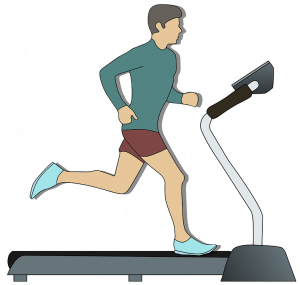 The standard physics treatment of activities involving the human body tends to ignore the energy of the body entirely. We may recognize that the we do positive work on an object when lifting and negative work on an object when lowering it. We may even recognize that when we do negative work on the object, the object does positive work on us. In general, most physics courses shy away from seriously exploring the implications of the positive work that is done on human bodies. Such an exploration would necessitate a move away from the clean energy accounting system which physicists love into much messier work.
The standard physics treatment of activities involving the human body tends to ignore the energy of the body entirely. We may recognize that the we do positive work on an object when lifting and negative work on an object when lowering it. We may even recognize that when we do negative work on the object, the object does positive work on us. In general, most physics courses shy away from seriously exploring the implications of the positive work that is done on human bodies. Such an exploration would necessitate a move away from the clean energy accounting system which physicists love into much messier work.
Physiological work is much more complicated then other types of work physicists typically teach about. Compare the work done by an elastic trampoline to the work done by a person. When a trampoline does negative work on a falling object the trampoline stores up elastic energy which can be used to launch the object back into the air. In contrast, when a person does negative work on heavy books as they take them down off a high shelf they certainly do not store up energy which can be used to raise the books back onto the shelf. In fact, both the positive work done on the books and the negative work done on the books causes the person to get tired. I would suggest that getting tired is exactly what we associate with physical work. So, in this case, doing positive physics work and doing negative physics work both require physical work. In this case, lowering the books requires less physical work because it is negative. If that last sentence seemed like a pathetic explanation, that is precisely the point. In the case of human work, teachers of physics are just not speaking the same language as manual labor.
The role of thermal energy is another source of discord between a traditional physics approach to energy and an experience based approach to human energy. In the case of the trampoline the role of thermal energy is fairly predictable. If everything were perfect, frictionless, vacuum, etc… then the object would bounce just as high off the trampoline as it fell from and no additional thermal energy would be generated. In the real world, the object doesn’t bounce quite as high and the difference can be attributed to a variety of ways in which energy is tranformed into thermal energy. This simple approach simply doesn’t apply in situations involving human work. If a person were a perfectly efficient book lifter they could transform chemical energy entirely into gravitational energy. If they were a perfectly efficient book lowerer, what would they be transforming the gravitational energy into. Of course not. The idea that thermal energy is generated when things aren’t perfectly efficient does cleanly apply to human work.
If embodied cognition is a significant piece of how we understand our physical world then it seems likely that the disconnect between physic work and physical work would have profound consequences for learning about the energetics of physical processes. Can we construct models for energy processes which explicitly use our embodied experience of effort and thermal energy. If so, will these models allow learners to more completely address the complexity of energy processes, both those involving the human body and those which do not.
The following is an elicitation question which is intended to explore these ideas.
Sue lives at the 15th floor of an office building. She like to get exercise by climbing the stairs to her office rather than taking the elevator. The building is air conditioned and always kept at a constant temperature of 72 F. She always walks up the stairs and down the stairs in the same amount of time. Sue notices that she consistently perspires more on the way up the stairs then she does on the way down.
What do you think is different about the energy transfers and transformations that Sue experiences on her way up and down the stairs? How can you account for the observation that she perspires more on the way up the stairs?
‘Some physics isn’t quite right here.
Last time I was on an inclined treadmill, my head (and attached torso) did NOT go “UP” as I hiked along. Most of me stayed at the same gravitational potential.
I did have to lift my legs more than on a flat treadmill but that, near as I can tell, was the only additional work I had to do. Not nearly as much work as climbing a hill.’
This comment blog comment inspires me to offer a second elicitation question:
Is it possible to engineer a treadmill to light a light bulb with no external energy source other than the person running on the treadmill? If so, should the treadmill be inclined, declined or horizontal?